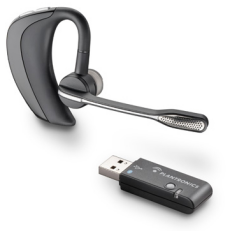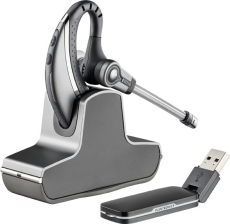Last week I blogged about Christmas coming early in the form of some goodies from ClearOne and Plantronics. Having given the speakerphones a thorough testing (hey, I work for IBM, there’s no shortage of opportunities to get on a conference call) it was time to give the headsets a proper going-over. My contact at Plantronics, Declan, provided three new headsets – one attaches to a computer using cables… imagine that. Old school, but about as simple as it gets for connecting and works with any operating system with no drivers… and the price point will suit those with a modest budget. Needless to say though, Plantronics’ wired headsets are far better quality than the ones you can pick up for £10 on the high street.
 Next up is the Voyager Pro… this baby uses Bluetooth to communicate between the USB adapter (some people call it a dongle, the documentation says it’s an adapter) and the headset. My previous Plantronics headset used this same USB adapter approach, and it’s a good way of getting round the possibility that your computer operating system’s support for Bluetooth may be a bit, errr, unreliable and difficult to set up. This, on the other hand, is dead easy… insert the USB adapter, switch on the headset, press the call control button, and they’re paired. Being Bluetooth-based it can also operate with your mobile phone.
Next up is the Voyager Pro… this baby uses Bluetooth to communicate between the USB adapter (some people call it a dongle, the documentation says it’s an adapter) and the headset. My previous Plantronics headset used this same USB adapter approach, and it’s a good way of getting round the possibility that your computer operating system’s support for Bluetooth may be a bit, errr, unreliable and difficult to set up. This, on the other hand, is dead easy… insert the USB adapter, switch on the headset, press the call control button, and they’re paired. Being Bluetooth-based it can also operate with your mobile phone.
The Voyager Pro is incredibly light, sits very comfortably on the ear and comes with a selection of ear buds to suit your own lug-hole. If you’re left-eared like me (seriously, I’m no good with phone calls in my right ear) the ear-piece and microphone can be reversed. In the box there’s all the right bits for charging and, a nice little touch, a carrying pouch. One more important thing… the sound quality. It’s fabulous, and considering it’s Bluetooth the range is excellent.
 The other device in the box of goodies was the Savi W430. It looks similar to the Voyager Pro – the over-ear piece is larger but still very light, and the microphone arm is longer. Again the box contains spare ear buds, a USB charging cable and a pouch, but it also includes a charging dock. The key difference is that the W430 doesn’t use Bluetooth – instead it uses DECT wireless technology routed through a USB adapter. This results in even greater range and should provide better sound quality with less interference… although I found that the sound quality of the Voyager Pro was so good that it was difficult to tell the difference. Using the W430 I could move from my home office upstairs and down into the kitchen with no sound break-up – Bluetooth doesn’t reach that far.
The other device in the box of goodies was the Savi W430. It looks similar to the Voyager Pro – the over-ear piece is larger but still very light, and the microphone arm is longer. Again the box contains spare ear buds, a USB charging cable and a pouch, but it also includes a charging dock. The key difference is that the W430 doesn’t use Bluetooth – instead it uses DECT wireless technology routed through a USB adapter. This results in even greater range and should provide better sound quality with less interference… although I found that the sound quality of the Voyager Pro was so good that it was difficult to tell the difference. Using the W430 I could move from my home office upstairs and down into the kitchen with no sound break-up – Bluetooth doesn’t reach that far.
In general, both of these Plantronics headsets offer excellent sound quality and easy set-up, and are well-constructed – you can tell these are top-quality devices. The Voyager Pro is reasonably-priced – you can pick one up for around £50 – but the Savi W430 will cost you around £189.
I’ll close by explaining why I’m spending time writing about headsets and speaker phones. We spend a lot of time talking to customers about telephony infrastructure and cost-reduction capabilities, but there’s one part of the solution that’s often not discussed… it’s the last three feet, the gap between the telephony client (Sametime Unified Telephony is the best choice) and your ears. If companies don’t think about this and don’t provide the right equipment, their users will end up shouting into their laptop’s in-built microphone and listening to the speakers. That’s a poor experience with no noise cancellation, no echo reduction, it picks up keyboard noise and is totally unsuitable for open-plan offices. That situation is going to stop people using their telephony solution and they won’t use the capabilities that will ultimately reduce communication costs. And that’s why good quality headsets are a worthwhile investment.
